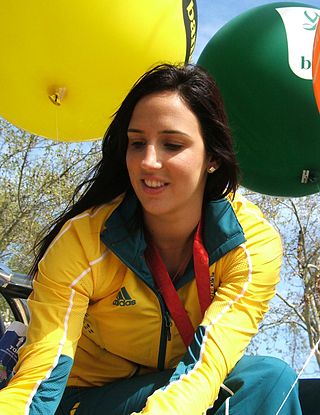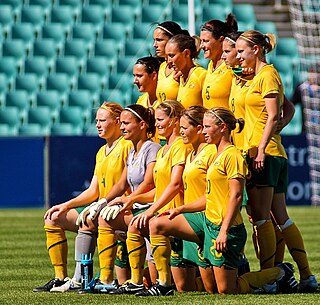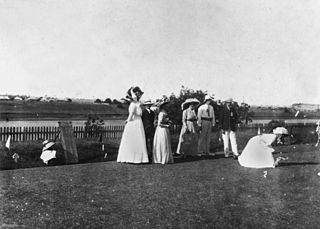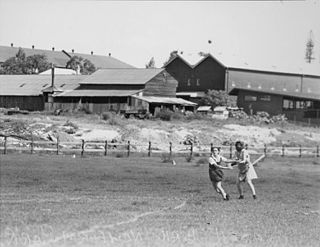Related Research Articles

Belinda Snell is an Australian women's basketball player. She is a member of the Australia women's national basketball team, and has won two silver medals in basketball at the 2004 & 2008 Summer Olympics, a bronze medal at the 2012 Summer Olympics, a gold medal at the 2006 Commonwealth Games, a gold medal at the 2018 Commonwealth Games, a gold medal at the 2006 World Championships, and a bronze medal at the 2014 World Championships.

Laura Hodges is an Australian female professional basketball player, having played in Australia's Women's National Basketball League (WNBL), Europe, and the WNBA. She currently plays for the Adelaide Lightning in the WNBL.
Softball in Australia is played in Australia.

Athletics is a popular sport in Australia, with around 34,000 athletes, officials and coaches currently registered with the national association.
Matthew Gray is an Australian archer. His day job is being a water policeman. He has participated in three Olympic Games and won a gold medal at the 2010 Commonwealth Games.

Women's soccer, also known as women's football, is a popular sport in Australia. The sport has a high level of participation in the country both recreational and professional. Football Australia is the national governing body of the sport in Australia, organising the A-League Women, the Australian women's national team, and the nine state governing bodies of the game, among other duties. Women's participation of modern soccer has been recorded since the early 1920s. It has since become one of Australia's most popular women's team sports.
Field hockey has been played by men in Australia since 1901. By 1907, there were clubs in several states including New South Wales, South Australia, Tasmania, and Victoria. Women's field hockey was eventually represented by the Australian Institute of Sport, though the amount of support it received was less than the support the men received. The All Australian Women's Hockey Association was established in 1910 to govern the sport in Australia. in 2000, Women's Hockey Australia merged with the Australian Hockey Association to form Hockey Australia. The game has been played by women on the university and school level. Interstate matches were being played by 1909. The level of play on the interstate level is very high. The Australia women's national field hockey team, established in 1914, has placed highly in many competitions.
Women's sport in Australia started in the colonial era. Sport made its way into the school curriculum for girls by the 1890s. World War II had little impact on women's sport in the country. After the war, women's sport diversified as a result of new immigrants to the country. In the 1990s, the percentage of media coverage for women's sport on radio, television and in newspapers was not at parity with male sport. Basketball is nominally professional in Australia but players do not earn enough from the sport to compete full-time. Some Australians have gone overseas to play professional sport. Many television spectators for Australian sport are women. In person, netball has large percentage of female spectators. The Australian Federal and State governments have encouraged women to participate in all areas of sport.

While not being urged to avoid competition, women had few opportunities to compete in sport in Australia until the 1880s. After that date, new sporting facilities were being built around the country and many new sport clubs were created. Athletic events were being held in schools in Australia by the early part of the twentieth century. The Glennie School in Toowoomba was one school to host races for girls during their annual girls' sport day. During the 1920s, girls were able to run while wearing bloomers, instead of skirts. The first meeting for women's athletics took place in 1926 and was organised by the NSWAAA. The purpose of the meeting was to determine if it would be possible to send women to compete in the 1928 Summer Olympics based on merit. Only one female athlete was determined to be good enough to send. That was E.F. Robinson. The first women's national athletics body designed to govern the sport in Australia was founded in 1932 and was called the Australian Women's Amateur Athletic Union. It was designed to oversee state organisations in Victoria (1929), Queensland (1921), New South Wales (1932) and South Australia. (1932) The first Australian woman to travel overseas to compete was E.F. Robinson, who went to the 1928 Summer Olympics where she ran in the 100-metres. She came in third and was the only Australian female on the 1928 Australian Olympic team.

The beginning of women's badminton in Australia dates back to the year 1900, when for the first time badminton was played in Australia.

The first women's bowls match played in Australia took place in Stawell, Victoria, in October 1881. The first women's only bowls club was not created for another seventeen years, when the Rainsford Bowls Club was created on 16 December 1898 at the home of J. Rainsford Needham, who lived in Glenferrie, Victoria. The first women's bowls association was created in September 1907. The association was called the Victorian Ladies' Bowling Association, and was created by six Melbourne-based clubs. It was the first women's bowling association created the world.

Croquet has historically been a sport in Australia where men and women were able to compete on a level playing field.
While not being urged to avoid competition, women had few opportunities to compete in sport in Australia until the 1880s. After that date, new sporting facilities were being built around the country and many new sport clubs were created. For swimming, the rapid expansion of facilities took place during the 1880s and the 1890s. Compared to the past when the whole of the swimming community was made up of males, currently 55 percent of the Australian swimming membership is made up of women. Not only do females dominate swimming in the pool but there are more than 5,500 female coaches in the swimming world in Australian and over 2,000 female technical officials.

While not being urged to avoid competition, women had few opportunities to compete in sport in Australia until the 1880s. After that date, new sporting facilities were being built around the country and many new sport clubs were created. One of the reason women were encouraged to play croquet, tennis and golf during the late 1800s was because it was seen as beneficial to their health. These sports were also seen as passive, non-aggressive and non-threatening to the period's concepts of masculinity and femininity.
Women's cue sports in Australia is a sporting topic that has received some Australian media coverage since the early 20th century. Coverage began with English billiards and today is more often about the sport of snooker and various pool games such as eight-ball.

In the 1880s in Victoria, there were school competitions for girls involving interschool competitions for rounders, an early form of baseball. The competitions were abandoned in the 1890s. Girls who played rounders/baseball during the 1880s and 1890s were required to wear long sleeved shirts and long skirts. These restricted a player's ability to move.
In 1940, a study of 314 women in New Zealand and Australia was done. Most of the women in the study were middle class, conservative, Protestant and white. The study found that 183 participated in sport. The twenty-fourth most popular sport that these women participated in was ice hockey, with one woman having played the sport. The sport was tied with baseball and bowls.
During the 1970s and 1980s, Australian women's basketball was successful in terms of attracting participants and having a competitive team on the international stages. This success did not translate into sponsorship and financial support for the sport.
Commonwealth Games Australia (CGA) is the Commonwealth Games Association for Australia, and is responsible for representing and promoting the Commonwealth Sport movement in the country, and organises the participation of athletes at the Commonwealth Games and Commonwealth Youth Games. It changed it name from the Australian Commonwealth Games Association to Commonwealth Games Australia in 2015. The Commonwealth Games have been held in Australia five times, most recently the 2018 Commonwealth Games were held on the Gold Coast, Queensland.
References
- ↑ Stell 1991 , p. 241
- ↑ Stell 1991 , p. 242
- ↑ Stell 1991 , p. 11
- ↑ Howard 1978 , p. 12
- ↑ Stell 1991 , p. 31
- ↑ Stell 1991 , p. 73
- ↑ Stell 1991 , p. 135
- ↑ Commonwealth Games Dehli 2010 Achery
- ↑ Australian archery, 2012 London Olympics
- ↑ Nihil 2006 , p. 103
- ↑ Nihil 2006 , p. 104
- ↑ Nihil 2006 , p. 107
- ↑ Nihil 2006 , p. 37